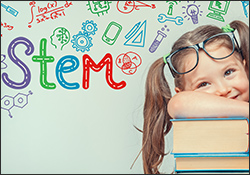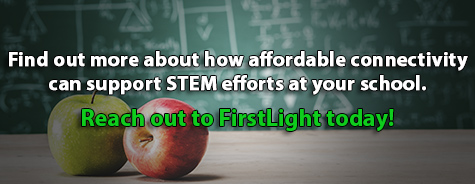
Many school districts are taking on initiatives to promote science, technology, engineering, and math (STEM) education in K through 12 institutions. STEM encourages young students to hone these skills in the hopes that they will go on to have careers in STEM fields.
STEM initiatives are spreading across the country. For example, the STEM Education Coalition 2017 Annual Report found that 41 out of 50 states have Statewide Afterschool Networks (SANs) for STEM. According to the report, 70% of SANs see more STEM advocacy than in previous years.
To make STEM initiatives successful, schools need access to reliable connectivity that scales to meet the growing needs of educational institutions. Through a high-speed network, students and teachers can access online STEM resources to enhance a specialized learning experience.
Why STEM Education Is Crucial
 The U.S. workforce needs more young people to study STEM so graduates can fill the growing number of jobs in associated fields. The Pew Research Center found that job growth in STEM fields has outstripped the overall job market. Employment in STEM positions has risen to 17.3 million, an increase of 79% since 1990.
The U.S. workforce needs more young people to study STEM so graduates can fill the growing number of jobs in associated fields. The Pew Research Center found that job growth in STEM fields has outstripped the overall job market. Employment in STEM positions has risen to 17.3 million, an increase of 79% since 1990.
Advocates of STEM education hope that students who are introduced to STEM at an early age will be more likely to choose related majors in college. Students may start out their K through 12 education with an aptitude for science and math but later lose interest and fail to develop the proper skills.
STEM programs also encourage the participation of members of underrepresented populations, such as girls, African Americans, and Hispanics. For example, the organization Girls Who Code is dedicated to providing after-school and summer programs for girls of all races and ethnicities who want to learn computer-programming skills.
How Technology Plays a Role in STEM Education
Technology gives students access to STEM education resources. By using mobile devices, students can participate in virtual labs to conduct simulated experiments using university-level equipment. Experiments can be repeated so students can correct and learn from their mistakes.
Students can also use mobile devices, such as smartphones and tablets, to watch STEM programs. STEM-oriented shows geared toward different age groups are available on networks such as PBS, Discovery, and National Geographic.
Special tablets are available that are pre-loaded with STEM-focused content. These STEM tablets can be used to conduct experiments or participate in learning modules. Students can use these tablets either individually or as a group to collaborate on a project.
The Challenges of Promoting STEM Education
 Even if schools have the desire to promote STEM education, they may lack the financial resources. School budgets are tight. The technology needed to conduct STEM lessons requires connectivity, and K through 12 schools may not have the budget to finance the right kind of network.
Even if schools have the desire to promote STEM education, they may lack the financial resources. School budgets are tight. The technology needed to conduct STEM lessons requires connectivity, and K through 12 schools may not have the budget to finance the right kind of network.
Schools need bandwidth sufficient to run numerous mobile devices in the classroom. A high-speed, low latency network is required to prevent buffering during STEM lessons conducted on mobile devices.
Putting STEM Education Within Reach
Fortunately, the FCC established the E-Rate Program to assist K through 12 institutions that are struggling to fund the high-speed networks needed to support STEM initiatives. E-Rate provides affordable Internet and telecommunications resources for schools and libraries.
Through the E-Rate Program, FirstLight provides Priority One services for K through 12 institutions. Priority One services include recurring telecommunications and Internet access.
When schools in the Northeast partner with FirstLight, they have an easier time achieving the connectivity and bandwidth they need to take advantage of STEM education opportunities. FirstLight is a proud supporter of STEM-related initiatives in the communities it serves. For example, FirstLight is part of the WNYT NewsChannel 13 STEM initiative (STEM13), promoting science, technology, engineering, and math education in New York schools. FirstLight is also a tech sponsor of Junior Achievement of Maine’s Titan Challenge, where over 300 high school students and business mentors use STEM skills to compete in a business simulation competition.
Find out more about how affordable connectivity can support STEM efforts at your school. Reach out to FirstLight today.






















